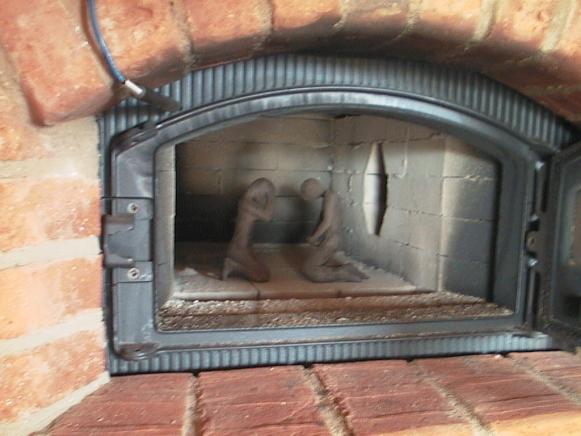 www.stenovne.dk/englishcentrifugalcarburator.html
www.stenovne.dk/englishcentrifugalcarburator.htmlThe two small figures (Narsissus and Ecco) are ceramic that just have beed burned.
They are not black, and they are burned all the way throug.
Ceramic will turn black if oxigen is missing for a short time.
So the temperature is o.k. and the mixing of gasses and oxigen has allso been o.k.
When the burning gasses enters the room from the throat in the floor just behind the door,
they can only leave throug the two hools located in the mittle of the sidewalls. (You see one of them at the right of the chamber)
Even gasses has a weight, and are affected by centrifugal forces, and when they enter this room, they are quit speedy
(thanks to Heikki´s invention of the throat), so they are forced into a spiral movement, where the latest gasses will keep up the heat of the first.
Furthermore - burned gasses are lighter than unburned gasses, so they come easyer into the mittle of this stream, and can leave the room
throug the two holes in the side.
The heavier gasses - those who are not burned yet - have to stay in the outher cirkel, untill they find som oxygen and can burn,
this way get lighter (allso because of the differens of temperature) and procide in the process.
This system functions allmost independently of the temperature of the stove, so the ordinary high contens of Co in the
beginning of a fire is allmost gone, and the overall average becomes extreemly low.
The system allso means, that you need less space to get a complete combustion.
Unless you put fare to mutch firewood into your firechamber, flames will not occured outside this "carburator".
That means, that you dont have to use anything else than one layer of ordinary bricks between your livingroom,
and the smokechannal just outside the bakeowen.
The temperature just outside the two holes will be less than the 572degrees Celcius that by time will damage ordinary bricks.
More freedom to build - mutch faster heat, if you come home from holliday to a real cold house, and a stove that dosn´t looks like Cassius Clay.
Remember:
This system we have used for allmost 20 years now.
You are wellcome to copy it, but please remember to tell where it came from.
Now we use it in our cookstoves to, but here it is located underneath the fireplace as an accessory
you can use when you don´t cook on the plate, and want a more clean burning and more heat to the buttom
of the cookstove. The "loss" is - no ash-dump, but that´s not so bad anyway.
In this case you off course have to have more than one damper to controll it.
In fact this is not so easy to explaine, but look out on my webpage for upcomming international work-shops,
where i whould love to tell you all about it.
Quistions are wellcome, but please - email me instead of phonecalls